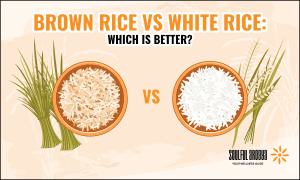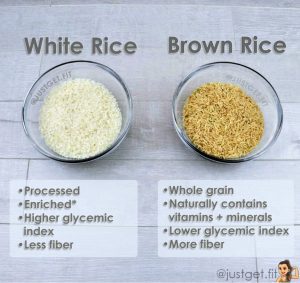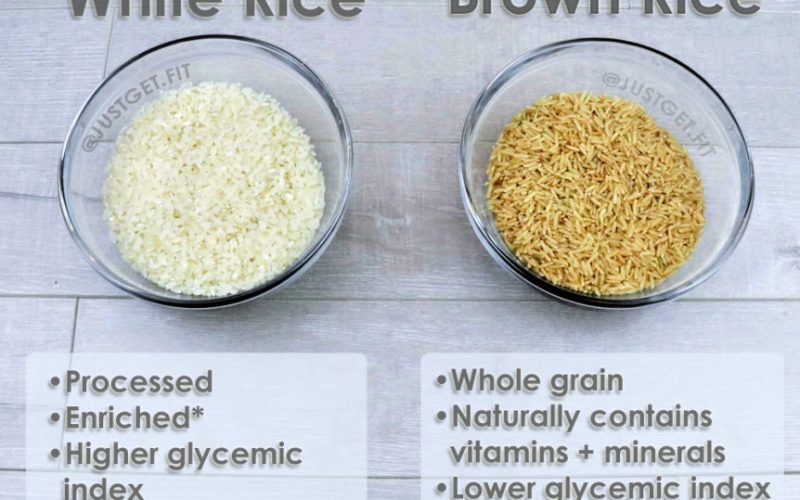Rice is a staple food for billions around the world, and the choice between brown and white rice can significantly impact your nutritional intake. In this comprehensive guide, we will delve into the nutritional profiles of both brown and white rice, highlighting the key differences in fiber, vitamins, and minerals. By the end of this article, you’ll have a thorough understanding of which type of rice aligns best with your dietary and nutritional needs.
The Rice Spectrum: Brown to White
Before we examine the nutritional differences, let’s understand the basic distinctions between brown and white rice.
Brown Rice
- Brown rice is the whole grain form of rice.
- It retains the bran and germ layers, giving it a brown color.
- The bran provides fiber and essential nutrients.
- It has a nuttier flavor and chewier texture.
White Rice
- White rice is milled to remove the bran and germ layers.
- This results in a polished, white appearance.
- It has a milder flavor and softer texture.
- The milling process removes many nutrients.

Image By:https://soulfularogya.b-cdn.net/wp-content/uploads/2015/12/Brown-Rice-vs-White-Rice-Soulful-Arogya.png
Nutritional Comparison
Let’s explore the significant nutritional differences between brown and white rice.
1. Fiber Content
Brown Rice:
- High in dietary fiber.
- Aids digestion and promotes a feeling of fullness.
- Supports steady blood sugar levels.
White Rice:
- Lower in fiber due to the removal of the bran.
- May lead to quicker spikes in blood sugar.
2. Vitamins
Brown Rice:
- Contains higher levels of vitamins, including B vitamins like thiamine, niacin, and vitamin B6.
- Rich in vitamin E, which acts as an antioxidant.
White Rice:
- Fewer vitamins remain after milling.
- Typically, white rice is fortified with some B vitamins and iron to compensate for nutrient loss.
3. Minerals
Brown Rice:
- Higher mineral content, including magnesium, phosphorus, and manganese.
- Magnesium supports muscle and nerve function, while manganese aids in bone health.
White Rice:
- Lower mineral content due to milling.
- May be enriched with some minerals like iron, but it’s still not as rich in minerals as brown rice.
4. Caloric Content
Brown Rice:
- Slightly higher in calories compared to white rice.
- The extra calories come from the bran and germ layers.
White Rice:
- Slightly lower in calories.
- The milling process reduces its calorie content.
5. Glycemic Index
Brown Rice:
- Has a lower glycemic index (GI), leading to a slower rise in blood sugar levels.
- A better option for individuals managing diabetes.
White Rice:
- Has a higher GI, which can result in faster spikes in blood sugar.
- May not be the best choice for individuals with diabetes.
The Bottom Line
The choice between brown and white rice ultimately depends on your dietary and nutritional needs.
Choose Brown Rice If:
- You want higher fiber content for digestive health.
- You’re looking for a more nutrient-dense option.
- You need to manage blood sugar levels.
Choose White Rice If:
- You prefer a milder flavor and softer texture.
- You require a lower-fiber diet due to certain health conditions.
- You appreciate the convenience of quicker cooking times.
Cooking and Storage Tips
If you decide to incorporate both brown and white rice into your diet, here are some cooking and storage tips:
- Storage: Keep rice in a cool, dry place, and seal it in an airtight container to prevent moisture and pests.
- Cooking: Rinse rice before cooking to remove excess starch. Use the appropriate cooking method and water-to-rice ratio for each type of rice.
- Mixing: Blend brown and white rice for a balance of texture and nutrition. For example, mix brown rice into white rice dishes to increase fiber and nutrient content.

Image By: https://justget.fit/wp-content/uploads/2017/10/white-rice-vs-brown-rice-862×814.jpg
Conclusion
The choice between brown and white rice is not just a matter of color; it’s about your health and nutritional needs. Understanding the nutritional differences between the two types of rice empowers you to make informed dietary choices. Whether you prioritize fiber and nutrients with brown rice or prefer the milder taste and quicker cooking of white rice, your decision should align with your personal wellness goals. In the end, both types of rice can be part of a healthy diet, and mixing them can provide a satisfying balance of flavor, texture, and nutrition.











